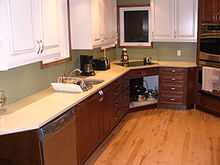Engineered stone
Engineered stone is a composite material made of crushed stone bound together by a polymer resin. It is used primarily for kitchen countertops and floor tiles. Related materials include geopolymers and cast stone. Unlike terrazzo, the material is factory made in slabs, cut and polished by fabricators, and assembled at the worksite.
Engineered stone products are gaining in popularity. Research reported in Consumer Reports (2010) magazine reveals virtually no difference in performance between quartz products and sealed granite.[1]

Engineered stone (US name) is also commonly referred to as 'quartz surface', 'quartz', agglomerate or agglomerated stone, the last term being that recognised by European Standards (EN 14618), although to add to the terminological confusion, this standard also includes materials manufactured with a cementitious binder.
Manufacturing Equipment
Breton S.P.A, a privately held company of Treviso Italy, is the dominant supplier of equipment for making engineered stone. A mixture of 93% quartz and 7% polyester resin is pressed into slabs (or larger blocks) using Breton's "vibrocompression vacuum process". [2] [3]
Although Breton was the original manufacturer of slab moulding equipment, there are now several other companies producing similar machinery. The Chinese company Keda Stone Machinery[4] being one of the largest.
China is currently the biggest market for new slab producing machines. There is estimated to be more than 100 engineered stone suppliers in China alone. India also has roughly 40 slab producing units as of December 2012.
Composition
Quartz is the major filler, although other material like coloured glass, shells, metals, or mirrors might be added. A typical material will consist of 93% quartz by weight and 7% resin. Different types of resins are used by different manufacturers. Epoxy and polyester resin are the most common types. Chemicals such as UV absorbers and stabilizers are added. To aid curing, peroxide is added.
Properties
Engineered stone is typically worked in the same way as natural stone using a water jet cutter or a diamond blade. This is in contrast with solid surface materials which can be cut with regular saws.[5]
The material can be produced in either 12 mm, 20 mm or 30 mm thicknesses. The most common slab format is 3040 mm x 1440 mm, but other sizes like 3040 mm x 1650 mm are produced according to market demand.
Engineered stone is less porous, more flexible, and harder than many types of natural stone. [citation needed] Less porous varieties are more resistant to mould and mildew than most natural stone types.[6] Since it has a unform internal structure, it does not have hidden cracks or flaws that may exist in natural stone. Its polyester resin binding agents allow some flexibility, preventing cracking under flexural pressure. But, the binding agents often continue to harden, leading to a loss of flexural strength over time. The polyester resins are not completely UV stable and engineered stone should not be used in outdoor applications. Continuous exposure to UV can cause discoloration of the stone, and breakdown of the resin binder.
The material is sometimes damaged by direct application of heat. Quartz engineered stone is less heat resistant than other stone surfaces including most granite, marble and limestone; but is not affected by temperatures lower than 150°C (300°F). Quartz engineered stone can be damaged by sudden temperature changes. Manufacturers recommend that hot pots and pans never be directly placed directly on the surface, and that a hot pad or trivet is used under portable cooking units.
When used as floor tiles, care is required in ensuring compatibility with the adhesive used. Reaction resin adhesives and rapid drying cementitious adhesives are generally successful, but bond failure can occur with other cementitious adhesives. Additionally, agglomerate stone tiles are more sensitive to both thermal expansion and contraction and to dampness from underlying screeds, necessitating the inclusion of movement joints at a higher frequency than for stone or ceramic floor tiles (see for example British Standard BS 5385-5: 2011) and verification by testing of the dryness of underlying layers.
See also
References
- ↑ Countertops: Our tests reveal the looks that last consumerreports.org Retrieved January 2, 2010.
- ↑ http://www.sitesnsolutions.com/Articles/History%20of%20Breton%20Process.htm
- ↑ http://www.breton.it/dynamic/en/catalogo/schedaProdotto.php?id=128&
- ↑ http://www.kedagroup.com
- ↑ Patrick Spielman, The New Scroll Saw Handbook,Sterling Publishing Company, Inc., 2002 ISBN 0-8069-7877-5 page 298
- ↑ "Bathroom Vanities". Retrieved 2012-06-21.
External links
- Engineered Stone Countertops Video
- Pros, Cons, and Cost of Engineered Stone
- Engineered Stone Countertops The Best Of Stone Without The Drawbacks